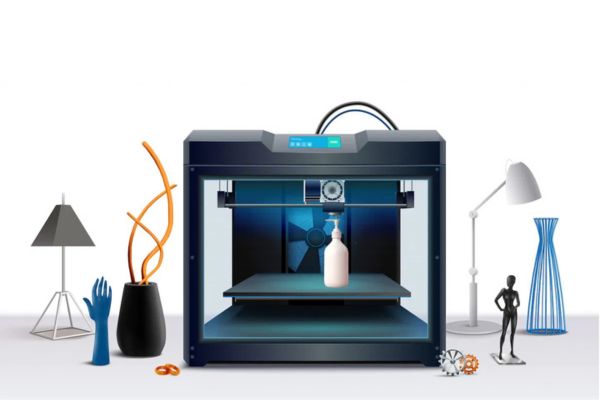The 3D printing market is poised for explosive growth, reaching an estimated $134.58 billion by 2034, according to a new report from Precedence Research. This represents a compound annual growth rate (CAGR) of 18.52% from 2025 to 2034.
This surge is fueled by rapid innovation across diverse industries such as construction, aerospace, and manufacturing. From 3D-printed homes to cutting-edge materials and even advancements in organ engineering, 3D printing is revolutionizing how products are designed and produced. North America currently dominates this market, contributing over 35% of the global revenue share in 2024, while industrial printers remain the backbone of manufacturing applications, accounting for a significant 77% revenue share.
What Are the Latest Trends Shaping the 3D Printing Industry?
- Robust Production and Specialized Plastics and Composites: A wide array of networks of companies provide their support and solutions for production processes to expand the 3D printing businesses. The assistance of design software through automated cleaning and sorting solutions is enhancing post-processing technologies. Several materials having elasticity, conductivity, biocompatibility, and reduced UV sensitivity have been developed and certified.
- Multi-material Printing and Hybrid Manufacturing: 3D printing enables the production of various materials with different properties in a single printed object. Multi-material printing reduced the need for material assembly by creating a diverse range of products through additive manufacturing. The different processes combine CNC machining and other technologies with additive manufacturing, and are moving towards more advancements.
- Automation in Manufacturing and Vapor Smoothing: The insertion of computer vision, AI, and thermal sensors into automation systems leads to labor savings and achieves cost efficiency. The adoption of vapor smoothing by several industries leads to improvements in surface finishes, which simplify production-level printing processes.
Limitations & Challenges in the 3D Printing Market
- Material Limitations and Slower for High Volume Manufacturing: 3D printing is still limited to certain materials than traditional manufacturing. This technology proves to be slower for large-scale production due to the individual printing of each part. The higher costs are required for large-scale production.
- High Initial Investments and Skill Requirements: The equipment, such as industrial-grade 3D printers, can be expensive, resulting in high costs of initial investments. A knowledge of 3D modelling and printer settings is required to use 3D printing. It requires skilled operation and setup.
- Intellectual Property Issues: It is possible to easily copy designs, which imposes risks and raises concerns about intellectual property.
Development of 3D Printing Platforms: Market’s Largest Potential
3D printing is becoming a rapidly changing and exciting sector with excellent innovations. It is transforming the existing industries and their industrial practices. On the basis of the global survey of Protolabs, about 77% of people believe the potential of this technology lies in the medical and healthcare sector.
The medical industry is incorporating the manufacturing of microscopic parts, while the construction industry, with housing, relies on 3D printing. The future of this technology relies on the advances in programmable 3D printing, AI-driven printing, 3D bioprinting, and in-situ printing.
- According to the global survey by Protolabs on market growth, ecosystem maturation, and technological innovations in 3D printing in 2024, the 3D printing market will expand up to $ 57.1 billion by the end of 2028. Moreover, 70% of businesses printed more parts in 2023 than in the year 2022, while 80% of respondents reported that 3D printing enabled them to save substantial costs.
- It has also been stated that 47% of respondents said that they preferred 3D printing over other manufacturing methods, than 44% of people in 2023. About 77% of respondents believe that 3D printing will have the most significant impact on the medical industry.
Which Market Segments Are Leading the 3D Printing Revolution?
Within the 3D printing ecosystem, industrial printers currently lead the market, but desktop printers are anticipated to grow at the fastest rate due to increasing accessibility and affordability. Stereolithography remains the dominant printing technology, while digital light processing (DLP), inkjet printing, and other emerging technologies are gaining momentum.
Prototyping continues to be the primary application driving demand, yet the functional parts segment is expected to witness the most rapid expansion. Vertically, the automotive industry leads adoption, with dental, fashion, and food sectors also poised for significant growth. Metal materials hold the largest market share, although polymers are rapidly gaining traction.
How Does the 3D Printing Market Vary Across Regions?
Geographically, North America is a key player, with the U.S. market alone projected to reach $34.28 billion by 2034, growing at a robust CAGR of 19.18%. Europe is anticipated to experience the fastest growth, driven by efforts to achieve technological independence in aerospace and a surge in rapid prototyping activities. These regional dynamics highlight the strategic importance of 3D printing technology in global manufacturing and innovation landscapes.
What Challenges Does the 3D Printing Industry Face?
Despite its promising outlook, the 3D printing industry faces several challenges. Material limitations remain a hurdle, as the variety of printable materials is still narrower compared to traditional manufacturing methods.
Scalability issues also persist, with 3D printing often being slower and more costly for large-scale production runs. Additionally, intellectual property concerns arise due to the ease of replicating digital designs, necessitating robust IP protection frameworks to safeguard innovation.
Who Are the Leading Companies in the 3D Printing Market?
The competitive landscape of the 3D printing market features several prominent players driving innovation and growth. Industry leaders include Materialise, 3D Systems, Autodesk Inc., GE Additive, and Voxeljet AG. These companies continue to invest in research and development, expanding their product portfolios and strengthening their market presence to meet the evolving demands of various sectors.

















